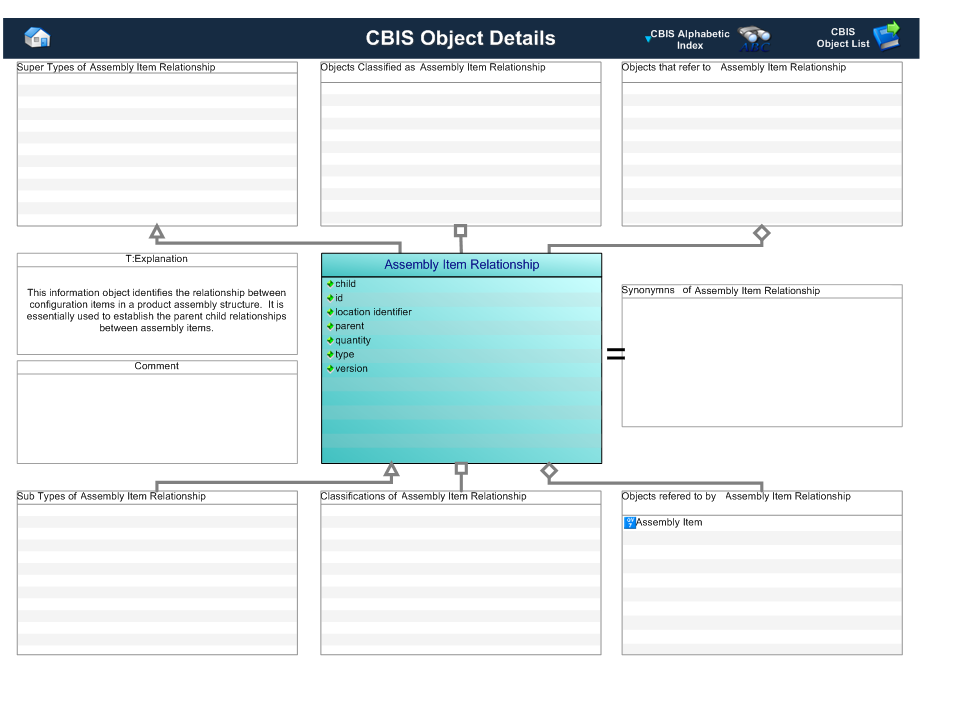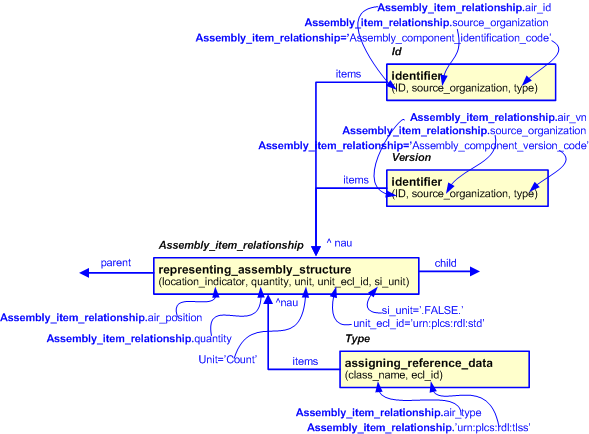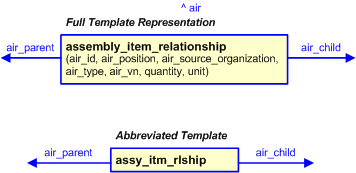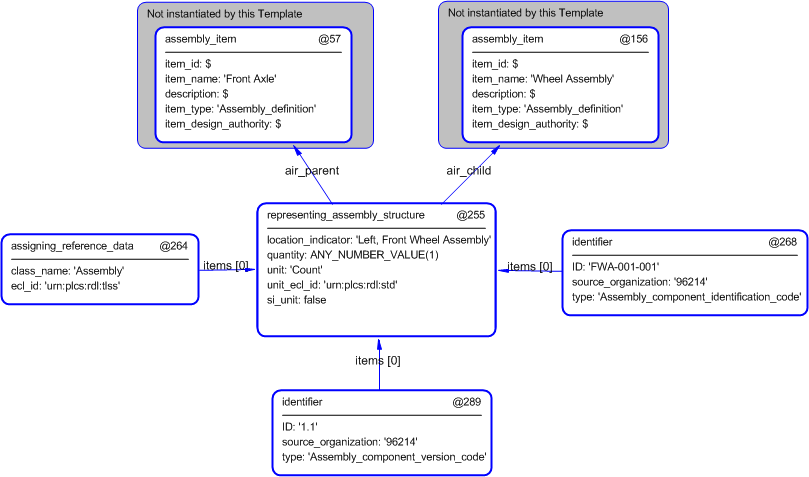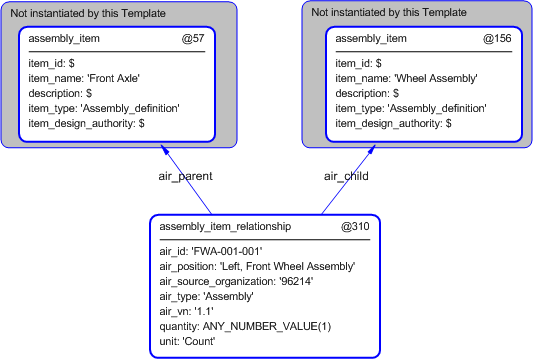Template:— assembly_item_relationship (assy_itm_rlship)
Context:— UK_Defence |
Date: 2009/04/17 10:45:29
Revision: 1.3
|
This section specifies the template assembly_item_relationship.
NOTE
The template has been defined in the context of
UK_Defence.
Refer to the business context for details of related templates.
NOTE
An explanation of a template and the associated instantiation path is
provided in the
Template overview
section.
This template describes how to represent the UK_Defence concept of a assembly item relationship
in terms of PLCS model elements (templates, entities, and reference data).
This template describes how to represent the relationship between configuration items in an assembly structure.
It is essentially used to establish the parent child relationships between assembly items.
Figure 1 — Graphical Representation for Business Object Assembly Item Relationship attribute details
This information object represents the configuration for an applicable item.
|
Attribute name
|
Attribute description
|
Attribute type
|
Optionality
|
| child |
This attribute identifies the child node in a hierarchical relationship. |
Relationship to an Assembly Item |
Mandatory |
| id |
This attribute provides an identifier associated with the assembly item relationship. |
Identifier |
Mandatory |
| locationidentifier |
This attribute provides an identifier for it's position within an assembly. |
Intrinsic |
Mandatory |
| parent |
This attribute specifies the parent or upper node in a hierarchical relatiohship |
Relationship to an Assembly Item |
Mandatory |
| quantity |
This is the quantity of child items that are contained within the parent. |
Intrinsic |
Mandatory |
| type |
This attribute provides the type of assembly item relationship being used.
For example, the relationship may be an alternative assembly relationship.
|
Intrinsic |
Mandatory |
| version |
This attribute captures the version information of the assembly item relationship. Subsequent versions may relate different
items.
|
Intrinsic |
Mandatory |
Table 1 — Assembly Item Relationship attribute details
The EXPRESS-G diagram in
Figure
2
shows the templates and EXPRESS entities that are required
to represent the template
"assembly_item_relationship".
The text highlighted in blue shows the template parameters.
Figure 2 — An EXPRESS-G representation of the Information model for assembly_item_relationship
The graphic for the template to be used in other EXPRESS-G diagrams
is shown in Figure
3
below.
Figure 3 — The graphical representation of the assembly_item_relationship template
The following input parameters are defined for this template:
This is the reference to the child in the relationship ie. that Part which is located in the assembly.
This is the identifier of the product assembly
This is the identifier of the part position in the assembly
The organization or information system that created the associated identifier. Alternatively
this could be set to /NULL and when Person or Information System is the source; see Identifier template characterizations
This is the name of the type of the class used to classify the relationship. The expected/default is for a normal
Assembly relationship, but others do exist, e.g. Disassembly
This is an indicator of whether the product composition relationship represents an installation of the child within
the parent
This is the reference to the parent in the relationship ie. that Part in which the related child Part is located
in the assembly.
The quantity of the child in parent assembly. If unspecified, '1' is assumed.
The class name of the unit in which the value is expressed.
The following classes and their sub-classes can be used:
The following reference parameters are defined for this template:
Allow the
Next_assembly_usage
entity instantiated in this path to be referenced when this template is used.
%^target = $assembly_item_relationship.air%
The following parameter combinations specify a uniqueness constraint:
Unique constraint: Unique assembly
Each instance of the
entity
(
Next_assembly_usage)
within the data set shall be uniquely identified
by a combination of the following parameters on this
template (assembly_item_relationship) namely:
air_parent,
air_child,
air_id.
The
instance is
referenced by the following template parameter:
air.
The parent and child(ren) should only occur once in a data set.
The instantiation path shown below specifies the entities that are to be
instantiated by the template.
A description of templates and the syntax for the instantiation path is
provided in the
Templates Help/Information section.
/
representing_assembly_structure(
parent=@air_parent,
child=@air_child,
location_indicator=@air_position,
quantity=@quantity,
unit=@unit,
unit_ecl_id='urn:plcs:rdl:std',
si_unit='false')/
%^air = $representing_assembly_structure.nau%
-- instantiate assigning_identification for the air identifier -- Note An Assembly_component_identification_code is an Idenitification_code that identifies a Assembly_component_relationship,
or subclass thereof. /
identifier(
ID=@air_id,
source_organization=@air_source_organization,
type='Assembly_component_identification_code',
items=^air)/
-- Assign air_type /
assigning_reference_data(
items=^air,
class_name=@air_type,
ecl_id='urn:plcs:rdl:uk_defence')/
-- instantiate assigning_identification for the air version /
identifier(
ID=@air_vn,
source_organization=@air_source_organization,
type='Assembly_component_version_code',
items=^air)/
The instance diagram in Figure
4
shows an example of the EXPRESS entities and templates that are instantiated by the template:
/assembly_item_relationship(air_child='@156', air_position='Left, Front Wheel Assembly', air_source_organization='96214', air_type='Assembly', air_vn='1.1', air_parent='@57', quantity='ANY_NUMBER_VALUE(1)', unit='Count')/
(an illustration of the consolidated assembly_item_relationship template is shown in
Figure
5 below.)
Figure 4 — Entities instantiated by assembly_item_relationship template
The instance diagram in
Figure
5
shows the graphic symbol for the template that is to be
used in other instance diagrams. The example template is:
/assembly_item_relationship(air_child='@156', air_position='Left, Front Wheel Assembly', air_source_organization='96214', air_type='Assembly', air_vn='1.1', air_parent='@57', quantity='ANY_NUMBER_VALUE(1)', unit='Count')/
Figure 5 — Instantiation of assembly_item_relationship template
Characterizations
No common characterizations of the template
assembly_item_relationship
have been identified. However, the ISO 10303-239 EXPRESS model
may enable other assignments to the entities instantiated by the template.
